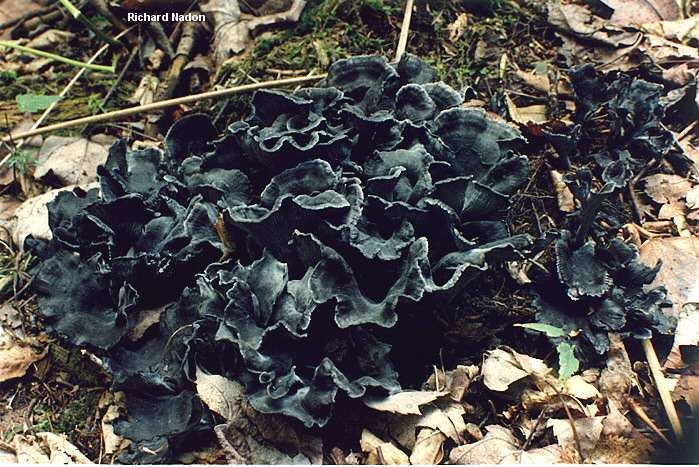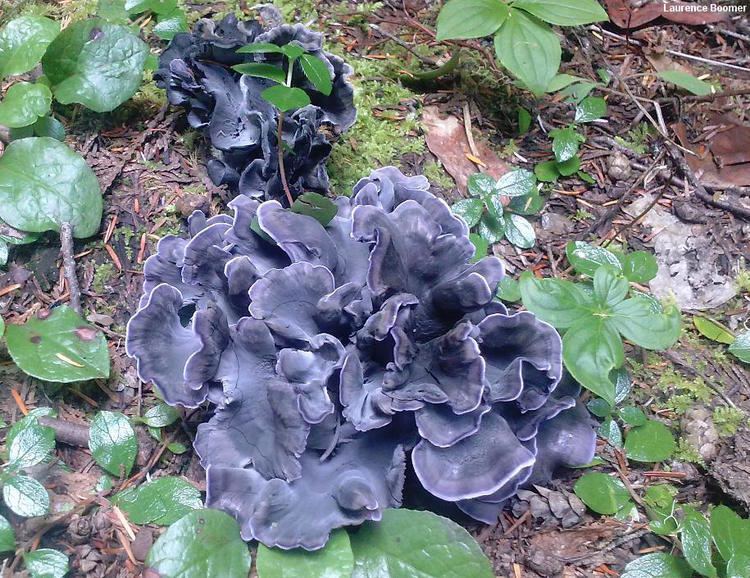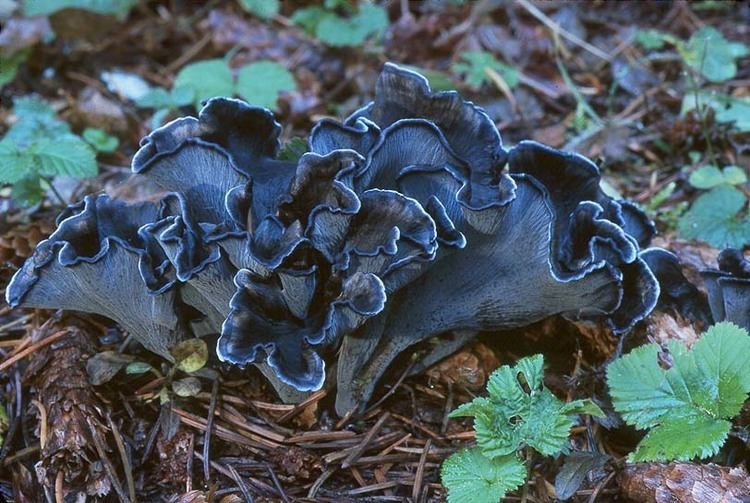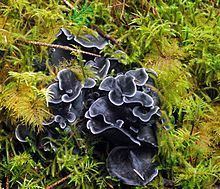Kingdom Fungi Class Agaricomycetes Species P. multiplex Rank Genus | Division Basidiomycota Scientific name Polyozellus multiplex | |
 | ||
Similar Cantharellus subalbidus, Thelephoraceae, Cantharellus formosus, Gomphus, Thelephorales | ||
Polyozellus is a fungal genus in the family Thelephoraceae, a grouping of mushrooms known collectively as the leathery earthfans. A monotypic genus, it contains the single species Polyozellus multiplex, first described in 1899, and commonly known as the blue chanterelle, the clustered blue chanterelle, or, in Alaska, the black chanterelle. The distinctive fruit body of this species comprises blue- to purple-colored clusters of vase- or spoon-shaped caps with veiny wrinkles on the undersurface that run down the length of the stem.
Contents
- History and taxonomy
- Description
- Microscopic characteristics
- Similar species
- Habitat and distribution
- Edibility
- Bioactive compounds
- Antitumor properties
- Cited literature
- References

Polyozellus has had a varied taxonomic history and has been reclassified several times at both the family and genus level. The range of Polyozellus includes North America and eastern Asia, where P. multiplex may be found growing on the ground in coniferous forests, usually under spruce and fir trees. It is an edible species, and has been harvested for commercial purposes. Polyozellus multiplex contains the bioactive compound polyozellin, shown to have various physiological properties, including suppressive effects on stomach cancer.

History and taxonomy

The first published description of the species was written by botanist Lucien M. Underwood in 1899, based on a specimen found the previous year in the woods of Mount Desert, Maine. Although he called the new species a Cantharellus, he noted that "the plant is a remarkable one and from its habit might well form a distinct genus since it has little in common with Cantharellus except its fold-like gills." In 1910, William Murrill transferred it to the new genus Polyozellus; Murrill thought the compound structure of the stem to be a sufficiently unique characteristic to warrant it being separated from Cantharellus species, which have simpler stem structures. In 1920, specimens from a Japanese collection compiled by A. Yasuda were sent to mycologist Curtis Gates Lloyd, who believed the fungus to be a new species and named it Phyllocarbon yasudai.

No further collections of the fungus were reported until 1937, when it was found in Quebec, Canada. The next year, Paul Shope considered the genus Polyozellus to be superfluous, pointed out that the compound fruit bodies and the wrinkled hymenium were instead consistent with the genus Craterellus. In 1939, American mycologist Lee Oras Overholts, in a letter to the journal Mycologia, opined that both of these authors had overlooked a 1925 publication by Calvin Henry Kauffman, who made notes and photos of the species collected in the Rocky Mountains of Wyoming and Colorado, and in the Cascade Mountains of Washington and Oregon. Kauffman believed the species to be merely "a very extreme growth condition" of Cantharellus clavatus (now known as Gomphus clavatus) and suggested there was no reason for transferring the species to the genus Craterellus. Mycologists Alexander H. Smith and Elizabeth Morse, in their 1947 publication on Cantharellus species in the United States, placed the species in a new section Polyozellus, but did not separate it from the genus Cantharellus; they defined the distinguishing characteristics of Polyozellus as the small, roughened, hyaline spores and the color change of the flesh in potassium hydroxide solution, adding that "the spores are unusual for the genus but in our estimation do not warrant excluding the species."
In 1953, Rokuya Imazeki took into consideration differences in spore characteristics: species in the genus Cantharellus were not known to have spores that were subglobose (roughly spherical) and tuberculate (covered with wart-like projections) like Polyozellus; however, these spore characteristics were common in species in the Thelephoraceae family (Cantharellus belongs in a different family, the Cantharellaceae). Other characteristics linking the blue chanterelle with the Thelephoraceae included the dark color, the strong odor (especially in dried specimens), and the presence of thelephoric acid, a mushroom pigment common in the family. Taken together, these factors led Imazeki to propose the new family Phylacteriaceae. The suggested family-level taxonomical change was not accepted by other authors; for example, in 1954, Seiichi Kawamura renamed it Thelephora multiplex. As of 2009, both Index Fungorum and MycoBank list Polyozellus as being within the Thelephoraceae family, a grouping of mushrooms commonly known as the leathery earthfans. The genus name is derived from the Greek poly meaning many, and oz, meaning branch. The specific epithet multiplex means "in many pieces", referring to the compound nature of the fruit body. Common names for this species include the blue chanterelle and the clustered blue chanterelle. In Alaska, where specimens typically have very dark-colored fruit bodies, it is called the black chanterelle, although this name is shared with some Craterellus species.
Description

Polyozellus multiplex is part of the group of fungi collectively known as cantharelloid mushrooms (which includes the genera Cantharellus, Craterellus, Gomphus, and Polyozellus) because of the similarity of their fruit body structures and the morphology of the spore-producing region (the hymenophore) on the underside of the caps. The fan- or funnel-shaped fruit bodies of the black chanterelle grow clustered together on the ground, often in large masses that may reach aggregate diameters of up to 1 meter (3.3 ft), although they are usually up to 30 centimeters (11.8 in).
The individual caps, 3–5 cm (1.2–2.0 in) wide and almost as long, are violet-black, with edges that are initially whitish, and with a glaucous surface—a white powdery accumulation of spore deposit. The upper surface may be zonate—lined with what appear to be multiple concentric zones of texture caused by areas of fine hairs (a tomentum); and the edges of the caps have a layer of very fine hairs and are lobed and wavy. The underside of the caps bears the fertile, spore-making tissue called the hymenium, which typically has shallow, crowded wrinkles or veins that are roughly the same color or paler than the top surface. Some variation in color has been observed depending on the collection location. For example, specimens found in Alaska are more likely to be jet-black in color with a dark gray underside.
Fruit bodies may be up to 15 cm (5.9 in) high (including the stem) and 10 cm (3.9 in) wide. Occasionally, much larger clusters of fused mushrooms are found, up to a meter in diameter. The stem is dark purplish-black with a smooth (glabrous) and dry surface; the stems are often fused at the base. It is typically 1.5–2 cm (0.6–0.8 in) wide and up to 5 cm (2.0 in) long. The flesh is dark violet, soft but breaking easily. The spore deposit is white.
Microscopic characteristics
The spores are roughly spherical to broadly ellipsoid in shape, covered with small wart-like projections (tubercules), and have dimensions of 6–8.5 by 5.5–8 µm. Viewed microscopically, they are hyaline, meaning they appear translucent or colorless. Chemical tests may also be used to help distinguish the spores: in the presence of potassium hydroxide (KOH), the spores turn slightly green; the spores are not amyloid, meaning they do not take iodine when treated with Melzer's reagent; the spores are acyanophilous, meaning they do not readily absorb methyl blue stain. The cystidia that comprise the hymenium are filamentous and 3–4 µm wide by 28–40 µm long. The outer tissue layer of the cap—the cuticle, or pileipellis—is made of interwoven hyphae, and stains olive-green in KOH. Clamp connections are present, but not at all the cell partitions. The basidia, the spore-bearing cells, are 32–38 by 5–6 µm and four-spored.
Similar species
The horn-of-plenty mushroom (Craterellus cornucopioides) also has a blackish fruit body and a smooth hymenium, but is distinguished from P. multiplex by its thin flesh, a trumpet- or tubular-shaped fruit body (rather than fan- or spoon-shaped), and grey to black colors. A closely related species, the fragrant chanterelle (Cantharellus odoratus), also tends to grow in dense clusters, but it is orange rather than blue. Craterellus caeruleofuscus does not form compound clusters, and is not restricted to coniferous forests. The pig's ear Gomphus, species Gomphus clavatus, is similar in shape and form but fleshier, and light violet to pink.
Habitat and distribution
Polyozellus multiplex is an ectomycorrhizal species, meaning that the hyphae of the fungus grow in a mutualistic association with the roots of plants, but the fungal hyphae generally do not penetrate the cells of the plant's roots. The species grows in coniferous woods under spruce and fir, and more frequently at higher elevations. It is most often encountered in summer and fall.
This species is northern and alpine in distribution, and rarely encountered. Collections have been made in the United States (including Maine, Oregon, Colorado, New Mexico, and Alaska), Canada (Quebec and British Columbia), China, Japan, and Korea. The disjunct distribution of this species in North America and East Asia has been noted to occur in a number of other fungal species as well. Polyozellus multiplex is also found in the Queen Charlotte Islands, where it is commercially harvested.
Edibility
Polyozellus multiplex is edible, and is collected for sale in Asian countries such as Korea, Japan, and China. In North America, it is sometimes collected recreationally, and commercially. The taste is described as mild, and the odor as mild or aromatic. Mycologist David Arora claims the flavor to be inferior to Craterellus. Fruit bodies may be preserved by drying.
Bioactive compounds
The compound polyozellin—a chemical which can be isolated and purified from P. multiplex—inhibits prolyl endopeptidase (PEP), an enzyme that has a role in processing proteins (specifically, amyloid precursor protein) in Alzheimer's disease. Chemicals that inhibit PEP have attracted research interest due to their potential therapeutic effects. Further analyses of extracts from P. multiplex revealed similar dibenzofuranyl derivatives of polyozellin, each with different chemical properties, including kynapcin-12, kynapcin-13 and -28, and -24. A total synthesis of kynapcin-24 was achieved in 2009.
Antitumor properties
Research conducted in 2003 suggests that extracts from Polyozellus multiplex may have suppressive effects on stomach cancer. The study showed that feeding a low concentration (0.5% or 1%) of the mushroom extract enhanced the activities of the enzymes glutathione S-transferase and superoxide dismutase, and increased the abundance of the molecule glutathione. The extract also augmented the expression of the protein p53. All of these substances protect the human organism against cancer. Additional studies reported in 2004 and 2006 attribute anti-tumor properties to polyozellin.
